Abstract
Pirfenidone and nintedanib have been approved for idiopathic pulmonary fibrosis (IPF) due to their ability to statistically slow, over a year, the rate of decline in lung forced vital capacity (FVC), neither drug has been reported to have o positive effects on high-resolution computed tomography (HRCT) of the chest, symptoms, or quality of life. Moreover, pirfenidone and nintedanib have substantial gastrointestinal tolerability issues. Overall, these data highly suggest that novel therapeutic approached are needed. CCN2 has been shown to be a mediator of fibrosis in many preclinical models. Anti-CCN2 strategies are in clinical development for IPF, A recent study by Richeldi and colleagues described the recent Phase II clinical trial for FG-3019 in IPF, and the results were highly encouraging. This commentary contextualizes and summarizes these exciting findings.
References
Allen JT, Knight RA, Bloor CA, Spiteri MA (1999) mEnhanced insulin-like growth factor binding protein-related protein 2 (Connective tissue growth factor) expression in patients with idiopathic pulmonary fibrosis and pulmonary sarcoidosis. Am J Respir Cell Mol Biol 21:693–700
Brenner MC, Krzyzanski W, Chou JZ, Signore PE, Fung CK, Guzman D, Li D, Zhang W, Olsen DR, Nguyen VT, Koo CW, Sternlicht MD, Lipson KE (2016) FG-3019, a human monoclonal antibody recognizing connective tissue growth factor, is subject to target-mediated drug disposition. Pharm Res 33:1833–1849
Igarashi A, Nashiro K, Kikuchi K, Sato S, Ihn H, Grotendorst GR, Takehara K (1995) Significant correlation between connective tissue growth factor gene expression and skin sclerosis in tissue sections from patients with systemic sclerosis. J Invest Dermatol 105:280–284
Igarashi A, Nashiro K, Kikuchi K, Sato S, Ihn H, Fujimoto M, Grotendorst GR, Takehara K (1996) Connective tissue growth factor gene expression in tissue sections from localized scleroderma, keloid, and other fibrotic skin disorders. J Invest Dermatol 106:729–733
Kinashi H, Falke LL, Nguyen TQ, Bovenschen N, Aten J, Leask A, Ito Y, Goldschmeding R (2017) Connective tissue growth factor regulates fibrosis-associated renal lymphangiogenesis. Kidney Int 92:850–863
Kleer CG (2016) Dual roles of CCN proteins in breast cancer progression. J Cell Commun Signal 10:217–222
Leask A (2019) A centralized communication network: Recent insights into the role of the cancer associated fibroblast in the development of drug resistance in tumors [published online ahead of print, 2019 Nov 7]. Semin Cell Dev Biol S1084–9521(18):30316–1. https://doi.org/10.1016/j.semcdb.2019.10.016
Lipson KE, Wong C, Teng Y, Spong S (2012) CTGF is a central mediator of tissue remodeling and fibrosis and its inhibition can reverse the process of fibrosis. Fibrogenesis Tissue Repair 5(Suppl 1):S24
Liu S, Shi-wen X, Abraham DJ, Leask A (2011) CCN2 is required for bleomycin-induced skin fibrosis in mice. Arthritis Rheum 63:239–246
Makino K, Makino T, Stawski L, Lipson KE, Leask A, Trojanowska M (2017) Anti-connective tissue growth factor (CTGF/CCN2) monoclonal antibody attenuates skin fibrosis in mice models of systemic sclerosis. Arthritis Res Ther 19:134
Parapuram SK, Thompson K, Tsang M, Hutchenreuther J, Bekking C, Liu S, Leask A (2015) Loss of PTEN expression by mouse fibroblasts results in lung fibrosis through a CCN2-dependent mechanism. Matrix Biol 43:35–41
Perbal B (2018) The concept of the CCN protein family revisited: a centralized coordination network. J Cell Commun Signal 12:3–12
Perbal B, Tweedie S, Bruford E (2018) The official unified nomenclature adopted by the HGNC calls for the use of the acronyms, CCN1-6, and discontinuation in the use of CYR61, CTGF, NOV and WISP 1-3 respectively. J Cell Commun Signal 12:625–629
Petrosino JM, Leask A, Accornero F (2019) Genetic manipulation of CCN2/CTGF unveils cell-specific ECM-remodeling effects in injured skeletal muscle. FASEB J 33:2047–2057
Richeldi L, Fernández Pérez ER, Costabel U, Albera C, Lederer DJ, Flaherty KR, Ettinger N, Perez R, Scholand MB, Goldin J, Peony Yu KH, Neff T, Porter S, Zhong M, Gorina E, Kouchakji E, Raghu G (2019) Pamrevlumab, an anti-connective tissue growth factor therapy, for idiopathic pulmonary fibrosis (PRAISE): a phase 2, randomised, double-blind, placebo-controlled trial. Lancet Respir Med 27. https://doi.org/10.1016/S2213-2600(19)30262-0 [Epub ahead of print]
Sato S, Nagaoka T, Hasegawa M, Tamatani T, Nakanishi T, Takigawa M, Takehara K (2000) Serum levels of connective tissue growth factor are elevated in patients with systemic sclerosis: association with extent of skin sclerosis and severity of pulmonary fibrosis. J Rheumatol 27:149–154
Schild C, Trueb B (2004) Three members of the connective tissue growth factor family CCN are differentially regulated by mechanical stress. Biochim Biophys Acta 1691:33–40
Sternlicht MD, Wirkner U, Bickelhaupt S, Lopez Perez R, Tietz A, Lipson KE, Seeley TW, Huber PE (2018) Radiation-induced pulmonary gene expression changes are attenuated by the CTGF antibody Pamrevlumab. Respir Res 19:14
Takigawa M (2018) An early history of CCN2/CTGF research: the road to CCN2 via hcs24, ctgf, ecogenin, and regenerin. J Cell Commun Signal 12:253–264
Tsang M, Quesnel K, Vincent K, Hutchenreuther J, Postovit LM, Leask A (2019) Insights into Fibroblast Plasticity: CCN2 Is Required for Activation of Cancer-Associated Fibroblasts in a Murine Model of Melanoma. Am J Pathol 11
Yeger H, Perbal B (2016) CCN family of proteins: critical modulators of the tumor cell microenvironment. J Cell Commun Signal 10:229–240
Author information
Authors and Affiliations
Corresponding author
Additional information
Publisher’s note
Springer Nature remains neutral with regard to jurisdictional claims in published maps and institutional affiliations.
Rights and permissions
About this article
Cite this article
Leask, A. Breathe, breathe in the air: the anti-CCN2 antibody pamrevlumab (FG-3019) completes a successful phase II clinical trial for idiopathic pulmonary fibrosis. J. Cell Commun. Signal. 13, 441–442 (2019). https://doi.org/10.1007/s12079-019-00542-6
Published:
Issue Date:
DOI: https://doi.org/10.1007/s12079-019-00542-6

